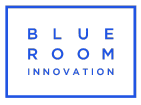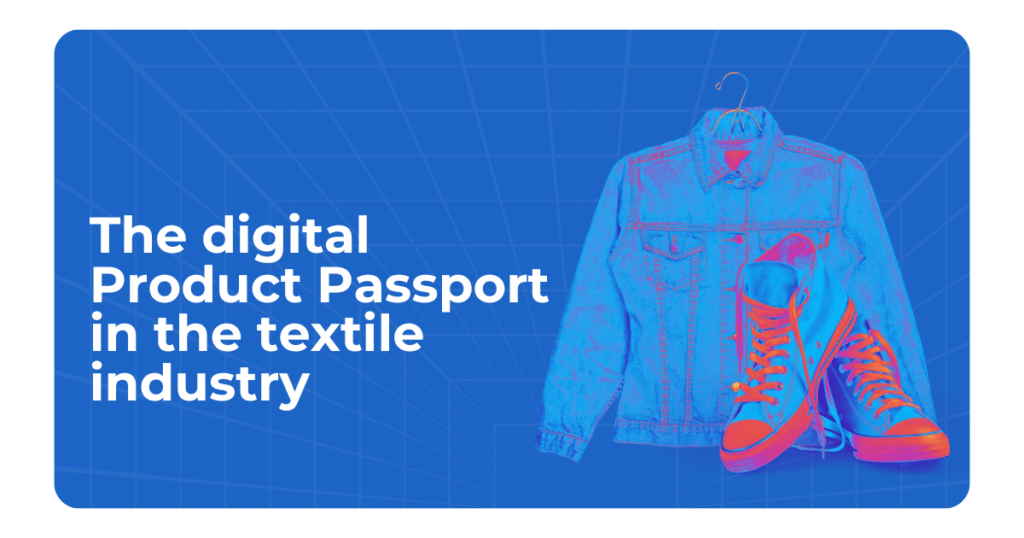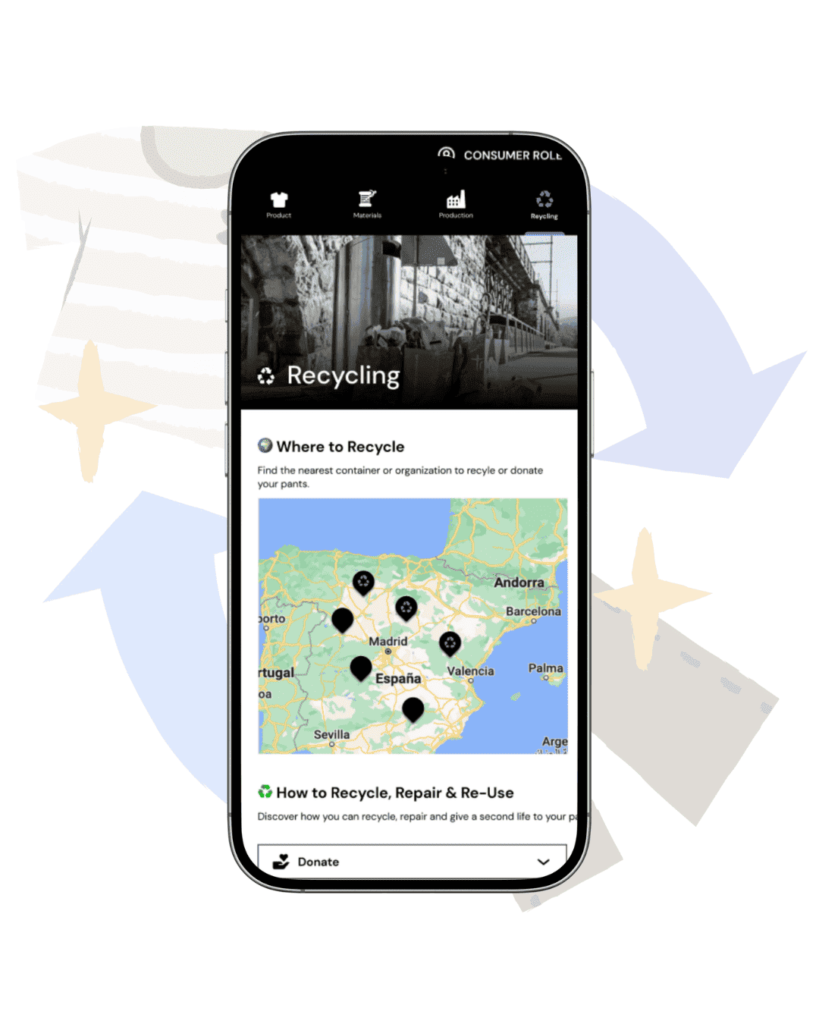

Textile Digital Product Passport: Transforming the industry toward circular and sustainable fashion
Textile Digital Product Passport: Transforming the industry toward circular and sustainable fashion
The textile industry occupies a prominent place globally, being an important economic engine, although faces significant challenges in terms of sustainability and environmental management. Over the years, the traditional model of fashion production and consumption has generated a significant environmental impact, with high levels of textile waste and resource consumption.
However, with growing concerns about sustainability, the European Union has promoted the implementation of new regulations, including the Textile Digital Product Passport, a tool designed to transform the way textile products are manufactured, consumed, and managed. Additionally, this digital system seeks to ensure transparency, improve product traceability, and promote more responsible practices throughout the world. textile supply chain. So, in this article, we will explore in detail how the Digital Textile Passport can be key in the transition to a circular fashion, what information it should contain, and how it can benefit both clothing manufacturers and consumers and the fashion industry in general.

The textile industry occupies a prominent place globally, being an important economic engine, although faces significant challenges in terms of sustainability and environmental management. Over the years, the traditional model of fashion production and consumption has generated a significant environmental impact, with high levels of textile waste and resource consumption.
However, with growing concerns about sustainability, the European Union has promoted the implementation of new regulations, including the Textile Digital Product Passport, una herramienta diseñada para transformar la forma en que se fabrican, consumen y gestionan los productos textiles.
Adicionalmente, este sistema digital, busca garantizar la transparencia, mejorar la trazabilidad de productos y promover prácticas más responsables en toda la textile supply chain.
Así, en este artículo, exploraremos en detalle cómo el Digital Textile Passport can be key in the transition to a circular fashion, what information it should contain, and how it can benefit both clothing manufacturers and consumers and the fashion industry in general.

What is the Digital Textile Product Passport?
What is the Digital Textile Product Passport?
The Textile Digital Product Passport (DPP) It is an innovative system driven by the European Union to improve the transparency and sustainability In the textile industry. This digital passport offers a complete digital representation of the product, containing key information about its life cycle, from the origin of the materials to its end of life.
Each textile product will have a unique identifier, linking the garment to a digital record accessible in real time. This record includes data on material composition, manufacturing processes, environmental impact, and recycling or reuse options. In this way, the DPP promotes the circular economy.r by ensuring that products are easily recyclable or reusable, reducing the environmental impact of the sector.
This system is part of the Ecodesign Regulation for Sustainable Products of the EU (ESPR), which seeks to reduce carbon emissions and waste generation in the textile industry, a sector that is currently responsible for 10% of global greenhouse gas emissions.
The Textile Digital Product Passport (DPP) It is an innovative system driven by the European Union to improve the transparency and sustainability In the textile industry. This digital passport offers a complete digital representation of the product, containing key information about its life cycle, from the origin of the materials to its end of life.
Each textile product will have a unique identifier, linking the garment to a digital record accessible in real time. This record includes data on material composition, manufacturing processes, environmental impact, and recycling or reuse options. In this way, the DPP promotes the circular economy.r by ensuring that products are easily recyclable or reusable, reducing the environmental impact of the sector.
This system is part of the Ecodesign Regulation for Sustainable Products of the EU (ESPR), which seeks to reduce carbon emissions and waste generation in the textile industry, a sector that is currently responsible for 10% of global greenhouse gas emissions.
Objectives of the Textile Digital Passport
The main objective of the Textile Digital Product Passport is improve transparency and sustainability within the textile industry. This system allows the entire life cycle of a garment to be tracked, from the materials used until his recycling, promoting more responsible production. To implement this strategy, one of the proposed technologies is blockchain. This is because, thanks to its use, the data on each product remains secure and unalterable, which increases the trust of both consumers and businesses.
In addition, the digital passport promotes the circular economy by facilitating the reuse and recycling of textiles and clothing. Through information on garment repair, the system helps reduce textile waste and extend product life. Thus, the DPP contributes to a more sustainable and efficient model in the fashion industry.
The passport also facilitates compliance with environmental regulations of the European Union, helping companies comply with regulations on sustainability and social responsibility.
Objectives of the Textile Digital Passport
The main objective of the Textile Digital Product Passport is improve transparency and sustainability within the textile industry. This system allows the entire life cycle of a garment to be tracked, from the materials used until his recycling, promoting more responsible production. To implement this strategy, one of the proposed technologies is blockchain. This is because, thanks to its use, the data on each product remains secure and unalterable, which increases the trust of both consumers and businesses.
In addition, the digital passport promotes the circular economy by facilitating the reuse and recycling of textiles and clothing. Through information on garment repair, the system helps reduce textile waste and extend product life. Thus, the DPP contributes to a more sustainable and efficient model in the fashion industry.
The passport also facilitates compliance with environmental regulations of the European Union, helping companies comply with regulations on sustainability and social responsibility.
Blockchain: The Key to Traceability
Blockchain technology plays a crucial role in the Digital Textile Passport, as it enables the product traceability throughout its entire lifespan. By storing information on a decentralized and immutable network, blockchain ensures that data on the production and recycling of garments cannot be altered.
This feature is essential to ensure transparency in the sector, especially in an industry that has historically been opaque regarding its environmental and labor practices. Furthermore, the use of blockchain offers an effective solution against the greenwashing, a phenomenon in which brands claim to be more sustainable than they actually are.
Blockchain: The Key to Traceability
Blockchain technology plays a crucial role in the Digital Textile Passport, as it enables the product traceability throughout its entire lifespan. By storing information on a decentralized and immutable network, blockchain ensures that data on the production and recycling of garments cannot be altered.
This feature is essential to ensure transparency in the sector, especially in an industry that has historically been opaque regarding its environmental and labor practices. Furthermore, the use of blockchain offers an effective solution against the greenwashing, a phenomenon in which brands claim to be more sustainable than they actually are.
What Information Should the Textile Passport Contain?
What Information Should the Textile Passport Contain?
The Textile Digital Passport is a crucial tool for the sustainability of the textile industry. Through a digital system based on a QR code, the passport provides detailed and verifiable information about each textile product. Thanks to blockchain technology, this information is secure, transparent, and immutable. The key elements that the passport must include are detailed below.
- Unique identifier: A code or number that allows for precise identification of the product.
- Brand and model: Information that allows the manufacturer and the specific type of garment to be identified.
- Product Summary: A brief description that includes details about the product, such as its purpose or intended use.
- Manufacturing location: Details about where garments are produced, allowing assessment of labor practices and local environmental impact.
- Manufacturers and suppliers: Information about the companies involved in garment production, from material suppliers to processors and distributors.
The Textile Digital Passport is a crucial tool for the sustainability of the textile industry. Through a digital system based on a QR code, the passport provides detailed and verifiable information about each textile product. Thanks to blockchain technology, this information is secure, transparent, and immutable. The key elements that the passport must include are detailed below.
- Unique identifier: A code or number that allows for precise identification of the product.
- Brand and model: Information that allows the manufacturer and the specific type of garment to be identified.
- Product Summary: A brief description that includes details about the product, such as its purpose or intended use.
- Manufacturing location: Details about where garments are produced, allowing assessment of labor practices and local environmental impact.
- Manufacturers and suppliers: Information about the companies involved in garment production, from material suppliers to processors and distributors.


- Type of materials: For example, organic cotton, recycled materials or synthetic fabrics.
- Origin of materials: Information about the source of the materials, allowing you to determine whether they are sustainable.
- Environmental effects: Details on the carbon footprint and other environmental impacts associated with the manufacturing of the materials.
- Energy efficiency indices: Indicators that show how the garment contributes to energy sustainability.
- Manufacturing: Information on practices used in production, such as water-saving techniques or the use of renewable energy.
- Distribution and sales: Data on transportation and emissions generated during product distribution.
- End of useful life: Information on how the product should be disposed of or recycled, supporting the circular fashion.
- Recyclability: Information on how easily the product can be recycled, supporting waste reduction.
- Ecological certifications: Such as GOTS (Global Organic Textile Standard), Fair Trade, or any other label that guarantees the product meets high environmental standards.
- Sustainability badges: Information about any awards or recognition received by the garment due to its ecological characteristics.


- Type of materials: For example, organic cotton, recycled materials or synthetic fabrics.
- Origin of materials: Information about the source of the materials, allowing you to determine whether they are sustainable.
- Environmental effects: Details on the carbon footprint and other environmental impacts associated with the manufacturing of the materials.
- Energy efficiency indices: Indicators that show how the garment contributes to energy sustainability.
- Manufacturing: Information on practices used in production, such as water-saving techniques or the use of renewable energy.
- Distribution and sales: Data on transportation and emissions generated during product distribution.
- End of useful life: Information on how the product should be disposed of or recycled, supporting the circular fashion.
- Recyclability: Information on how easily the product can be recycled, supporting waste reduction.
- Ecological certifications: Such as GOTS (Global Organic Textile Standard), Fair Trade, or any other label that guarantees the product meets high environmental standards.
- Sustainability badges: Information about any awards or recognition received by the garment due to its ecological characteristics.
Benefits of the Digital Textile Passport
Benefits of the Digital Textile Passport
The Digital Textile Passport offers several benefits for both textile companies as for the consumers.
For Clothing Manufacturers and Textile Companies
The digital passport helps textile companies manage sustainability throughout the supply chain. Backed by blockchain, companies can ensure product traceability, allowing them to demonstrate that their products meet sustainability standards and textile certifications. Furthermore, the implementation of theTextile Digital Product Passport facilitates compliance with European Union regulations.
For Consumers
Consumers benefit greatly from the Digital Textile Passport by being able to access transparent and verifiable information about the lifecycle of the garments they purchase. Thanks to blockchain, consumers have access to immutable data on the sustainability and environmental impact of products. This allows them to make informed decisions, choosing more environmentally responsible products.
For the Textile Sector and the Circular Economy
The Digital Textile Passport also benefits the fashion industry by promote circular fashion. By promoting the reuse and recycling of textile products, the digital passport helps reduce textile waste. Furthermore, the use of blockchain allows manufacturers and consumers to ensure that recycled products meet sustainability standards, contributing to a more robust circular economy model.
The Digital Textile Passport offers several benefits for both textile companies as for the consumers.
For Clothing Manufacturers and Textile Companies
The digital passport helps textile companies manage sustainability throughout the supply chain. Backed by blockchain, companies can ensure product traceability, allowing them to demonstrate that their products meet sustainability standards and textile certifications. Furthermore, the implementation of theTextile Digital Product Passport facilitates compliance with European Union regulations.
For Consumers
Consumers benefit greatly from the Digital Textile Passport by being able to access transparent and verifiable information about the lifecycle of the garments they purchase. Thanks to blockchain, consumers have access to immutable data on the sustainability and environmental impact of products. This allows them to make informed decisions, choosing more environmentally responsible products.
For the Textile Sector and the Circular Economy
The Digital Textile Passport also benefits the fashion industry by promote circular fashion. By promoting the reuse and recycling of textile products, the digital passport helps reduce textile waste. Furthermore, the use of blockchain allows manufacturers and consumers to ensure that recycled products meet sustainability standards, contributing to a more robust circular economy model.


Who should implement the Textile Digital Product Passport?
Who should implement the Textile Digital Product Passport?
The Textile Digital Product Passport must be implemented by various stakeholders within the textile supply chain. First, Clothing manufacturers are responsible for integrating this system into their production processes. This involves assigning a unique identifier to each garment and providing data related to the material composition, manufacturing process, and environmental impact of the product.
On the other hand, distributors and retailers They also have an important role in implementation. They must ensure that the garments they sell include the Textile Digital Passport to guarantee transparency of information for consumers. Additionally, they will be responsible for promoting the adoption of this system and educating consumers on how to use it to make more informed decisions.
The regulatory authorities They also play a key role, as they are responsible for monitoring compliance with regulations and ensuring that the data provided is verified and accurate.
The Textile Digital Product Passport must be implemented by various stakeholders within the textile supply chain. First, Clothing manufacturers are responsible for integrating this system into their production processes. This involves assigning a unique identifier to each garment and providing data related to the material composition, manufacturing process, and environmental impact of the product.
On the other hand, distributors and retailers They also have an important role in implementation. They must ensure that the garments they sell include the Textile Digital Passport to guarantee transparency of information for consumers. Additionally, they will be responsible for promoting the adoption of this system and educating consumers on how to use it to make more informed decisions.
The regulatory authorities They also play a key role, as they are responsible for monitoring compliance with regulations and ensuring that the data provided is verified and accurate.
Implementation phases
Implementation phases
One of the most common questions about the digital garment passport is when it should be mandatory. The implementation of the Digital Textile Product Passport (DPP) is a gradual process that will be rolled out in several key phases between 2024 and 2030. This phased approach is designed to enable textile companies to efficiently adapt to new sustainability regulations and requirements established by the European Union.
According to the study carried out by the Panel for the Future of Science and Technology (STOA) of the European Union, titled "Digital Product Passport for the Textile Sector", the key phases for implementing the Digital Textile Product Passport have been identified. This report offers a detailed analysis of the timelines and actions required to ensure that textile companies comply with transparency and environmental responsibility requirements throughout the supply chain.
Phase 1 (2024-2025): During this initial phase, Textile companies must begin preparing for the digitalization of their products. This includes collecting data on material composition and basic supply chain traceability. It's time to establish the necessary systems to integrate digital passports into production processes.
Phase 2 (2026-2027): From 2026, the Companies must implement a basic passport containing information on recyclability, environmental impact, and key production details. This is the transition period where brands must be fully aligned with sustainability regulations.
Phase 3 (2027-2030): Since 2027, the digital passport will be mandatory. Companies must ensure that their products have complete lifecycle information, including repairability, recycling, and end-of-life data. Furthermore, audits and compliance with sustainability regulations will be essential.
One of the most common questions about the digital garment passport is when it should be mandatory. The implementation of the Digital Textile Product Passport (DPP) is a gradual process that will be rolled out in several key phases between 2024 and 2030. This phased approach is designed to enable textile companies to efficiently adapt to new sustainability regulations and requirements established by the European Union.
According to the study carried out by the Panel for the Future of Science and Technology (STOA) of the European Union, titled "Digital Product Passport for the Textile Sector", the key phases for implementing the Digital Textile Product Passport have been identified. This report offers a detailed analysis of the timelines and actions required to ensure that textile companies comply with transparency and environmental responsibility requirements throughout the supply chain.
Phase 1 (2024-2025): During this initial phase, Textile companies must begin preparing for the digitalization of their products. This includes collecting data on material composition and basic supply chain traceability. It's time to establish the necessary systems to integrate digital passports into production processes.
Phase 2 (2026-2027): From 2026, the Companies must implement a basic passport containing information on recyclability, environmental impact, and key production details. This is the transition period where brands must be fully aligned with sustainability regulations.
Phase 3 (2027-2030): Since 2027, the digital passport will be mandatory. Companies must ensure that their products have complete lifecycle information, including repairability, recycling, and end-of-life data. Furthermore, audits and compliance with sustainability regulations will be essential.


The Textile Digital Product Passport represents a fundamental step toward a more sustainable and transparent textile industry. Through the traceability of each garment, this system allows consumers to make informed decisions about the sustainability of the products they purchase. Furthermore, being backed by blockchain, it ensures that the information provided is secure, unalterable, and reliable.
In this way, the DPP not only improves transparency in the textile supply chain, but also supports the circular economy, promoting the reuse and recycling of products. The gradual implementation of this system will allow companies to adapt to new regulations and the fashion industry to move toward a more responsible and ethical model.
Thus, the Textile Digital Product Passport is key to reducing the industry's environmental impact and fostering a more circular and sustainable economy in Europe and beyond.
The Textile Digital Product Passport represents a fundamental step toward a more sustainable and transparent textile industry. Through the traceability of each garment, this system allows consumers to make informed decisions about the sustainability of the products they purchase. Furthermore, being backed by blockchain, it ensures that the information provided is secure, unalterable, and reliable.
In this way, the DPP not only improves transparency in the textile supply chain, but also supports the circular economy, promoting the reuse and recycling of products. The gradual implementation of this system will allow companies to adapt to new regulations and the fashion industry to move toward a more responsible and ethical model.
Thus, the Textile Digital Product Passport is key to reducing the industry's environmental impact and fostering a more circular and sustainable economy in Europe and beyond.
At Blue Room Innovation, nos especializamos en el desarrollo de Pasaportes Digitales de Producto que ofrecen una trazabilidad completa de los productos en la industria textil, utilizando tecnologías avanzadas como blockchain. Nuestro sistema permite a las empresas y consumidores acceder a información detallada sobre cada prenda, desde su composición e impacto ambiental hasta su reciclaje y reutilización.
In addition, we are collaborating on the project Intransit, where we are integrating our Textile Digital Product Passport with the LCA calculation platform of BawareThis integration enables companies to efficiently manage the environmental impact and sustainability of their textile products, offering a robust and scalable solution to support the circular economy and comply with European Union regulations.
At Blue Room Innovation, we specialize in developing Textile Digital Product Passports that offer complete product traceability in the textile industry, utilizing advanced technologies such as blockchain. Our system allows companies and consumers to access detailed information about each garment, from its composition and environmental impact to its recycling and reuse.
In addition, we are collaborating on the project Intransit, where we are integrating our Textile Digital Product Passport with the LCA calculation platform of BawareThis integration enables companies to efficiently manage the environmental impact and sustainability of their textile products, offering a robust and scalable solution to support the circular economy and comply with European Union regulations.
Products
Digital Product Passport
Descentralized platforms
Descentralized Identity
Verificable Credentials
About us
Team
Methodology
Our Mission
Connect
Cristòfol Grober 4, local 35
17001 - Girona
info@blueroominnovation.com
Follow us
Copyright © 2024 Blue Room Innovation Privacy Policy - Legal Warning - Cookies Policy